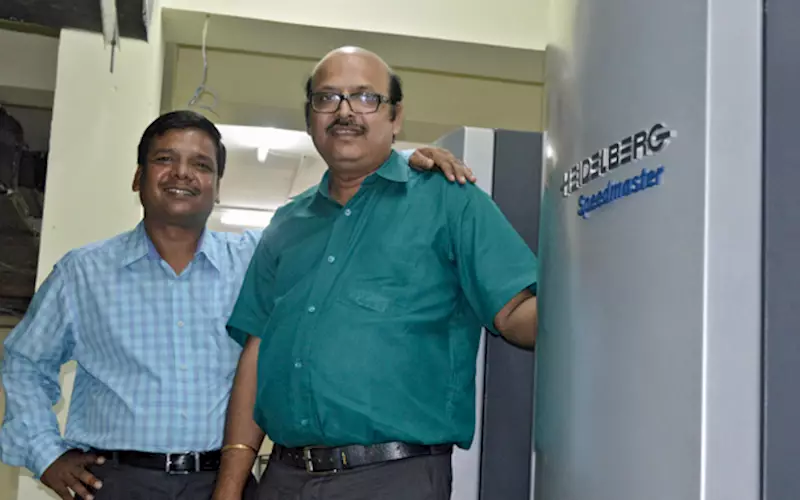Print-Tech Offset: 17,000 calendars in two days on a CS 92 Heidelberg press
Brundaban Behera and BR Nayak of Print-Tech say they felt the need to improve when a client, the publisher of a leading Odia language magazine Kadambini hinted at improving the print quality.
14 Jun 2017 | By Priya Raju
Q: Print-Tech Offset recently completed two-decades in the print business, how did it all start?
Brundaban Behera (BB): B R Nayak (BRN) and I are print engineers and we wanted to establish something of our own. It was in 1996, to cater to requirements of Kalinga Institute of Social Sciences (KISS) and KIIT University that Print-Tech set shop in Bhubaneshwar. The press gained traction after we installed two Polly four-colour presses in 2007 and 2008 respectively. The printing press has grown from a small gala to a 12,000 sq/ft plant with an additional 2,000 sq/ft storage area.
Q: Which market segments do you cater to and what is the firm’s capacity?
BB: We predominantly cater to the commercial printing segment, magazines and publishing houses. We currently employ 71 people working in two shifts of eight hours. We have an installed capacity of two-lakh impressions per day on the web and four-lakh impressions per day on sheetfed.
Q: You were one of the first printers to invest in a new four-colour press, what prompted you to do so?
BRN: Yes, we felt the need to improve when one of our clients, the publisher of the leading Odia language magazine Kadambini hinted at improving the quality. That’s when we seriously considered buying a new kit. We invested in a new Heidelberg press in 2008, and we could immediately see the difference. In 2010, we became the first printer in Orissa to install a new press and a CTP kit – a Heidelberg SM 74 and a Suprasetter A-75.
Q: Why did you decide in on Heidelberg machines?
BB: Heidelberg is a renowned brand with proven technology. When we first invested in the Heidelberg press in 2008, we could see the difference in quality.
Q: You have invested in a new Heidelberg CS 92 press...
BB: We invested in the press owing to a growing market demand. Features like complete automation, ease of operation, sturdiness and the considerable reduction in wastage is why we opted for Heidelberg CS 92. The print requirements, which were earlier outsourced to Hyderabad or Kolkata, are now catered by us.
Q: How has the machine’s performance been?
BRN: For the past year the machine has been running smoothly with timely support from the Heidelberg team. This has equipped us to handle high volume jobs on short notice. For example, we recently got an order to print 1,70,000 calendars in two days. Due to this machine, we could cater to this in a jiffy.
Q: How has demonetisation impacted the print sector in your area?
BB: Post-demonetisation, the market was sluggish and there was definitely a slowdown in business. But the market has picked up since then.
Q: Currently, what are the printing trends that you observe in Odisha and Bhubaneshwar?
BB: The past three to four months have been a difficult time since Ballarpur paper mill has shut down. It has become very difficult to find the required paper and this has resulted in a tremendous loss for us.
Q: And there has been an abrupt hike in paper prices too…
BB: Yes, it has resulted in direct losses for us. As we cater to the government organisations wherein jobs are tender based and prices are fixed for a year. For example, initially we had quoted Rs 65 as the cost for paper, but now the rates are above Rs 75. While importing paper is always an option, the delivery time is often sporadic.
Q: What are your plans for Print-Tech in the coming years?
BRN: For our shopfloor, the target is to run the production with 80% utilisation. There has been an increasing demand for quality prints but to extract the appropriate rates has been an issue. There is a huge scope for growth and to achieve that, the in general, laidback attitude of the industry has to change.
Print-Tech fact file
Established: 1996 in Bhubaneshwar
Area: 12,000 sq/ft plus 2,000sq/ft for storage
Employee strength: 71 employees working in two shifts of eight hours
Printing machines: Heidelberg Suprasetter A-75 CTP for pre-press, four web-offset presses along with two Heidelberg SM 74 presses, Heidelberg SX 52, Heidelberg CS 92 and Polly 466 sheetfed press
Press capacities:
Two lakh impressions per day on the web
Four lakh impressions per day on sheetfed
Post-press: Heidelberg Stahl folding, Welbound colt and six-clamp perfect binding machine, sewing machine, case making with cold and thermal lamination, and foiling














 See All
See All